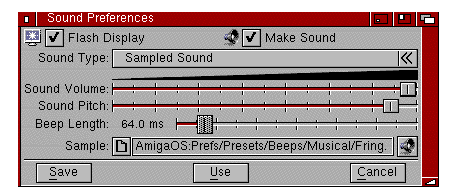
The Serial editor, illustrated in Figure 5-9, sets specifications for serial communication on your system.

Serial Preferences Editor Window
Serial information sent and received through modems or networks must be in a form compatible with the device with which you are communicating. Refer to the documentation packages that came with your serial device to determine appropriate settings.

The baud rate determines the number of bits transferred through the serial port each second. In serial communication, information is sent and received one bit at a time. Since characters are usually 10 bits (1 start bit, 8 data bits, 1 stop bit), dividing the baud rate by 10 approximates how many characters per second (cps) are transmitted.
The selected baud rate must match the rate of the device with which you are communicating. The larger the value, the faster the data is transferred. The available rates are: 110, 300, 1200, 2400, 4800, 9600, 19200, and 31250 baud. The current rate setting is shown to the left of the slider. The default setting is 9600.

The input buffer is an area of memory set aside for incoming serial data. The available sizes are: 512, 1024, 2048, 4096, 8192, 16384, 32768, and 65536 bytes. The current size is shown to the left of the slider. Use a larger buffer when working with a high baud rate or when the Amiga is performing many tasks. The default setting is 512.

Handshaking controls the flow of information through the serial port and the attached device. The same handshaking method must be set for both the computer and the device to allow communication. The available choices are:

Parity detects transmission errors by checking a bit of each character, called the parity bit, for its setting. The available parity settings are:

Bits per character specifies the number of bits that are sent through the serial port for each character and the number of bits expected for each character received.
This setting should correspond with the setting for parity. If parity is set to Even, Odd, Mark, or Space, set bits per character to 7 since some systems use the eight bit of data for parity checking. If parity is set to None, set bits per character to 8.
Stop bits are extra bits added at the end of a character to allow the computer to interpret spacing between words and indicate when a transmission ends. This applies to characters both sent and received through the serial port.
Slower processing computers usually require two stop bits. Computers that transfer information at 300 baud or faster generally require one stop bit. If you are using eight data bits, use only one stop bit or you may lose data during transmission.

If you have additional serial ports on your system, you can specify a default unit by adding a UNIT command line option or putting a UNIT Tool Type in the program's icon. The causes a Default Unit text gadget to appear in the Serial editor window. In this gadget, enter the unit number of the port that should be used when a particular port has not been otherwise specified. Entering 0 or 1 specifies the motherboard serial port. The documentation for your serial expansion device should give the unit numbers to use for its ports. Settings made in the Serial editor affect all ports.

The Sound editor lets you determine the type of sound and sound attributes produced by your Amiga. The Amiga can flash the screen and/or issue a beep to signal of an application prompt or error in processing. The Sound editor window is illustrated in Figure 5-10.

Sound Preferences Editor Window
|
Your Amiga or monitor must be equipped with speakers for it to make sound. Consult your hardware documentation or Amiga dealer for information on connecting speakers. |
You can choose Make Sound, Flash Display, or a combination of both. Do not turn both functions off at the same time since that disables all signaling capability, which could cause you to miss a prompt.
Choosing Flash Display alone causes the Amiga to signal a prompt or error by flashing the screen.
If you choose Make Sound, you have the following options:
After you choose Beep or designate your sample sound, you can test the sound to be sure it has all the attributes that you want by selecting Test Sound. The Save, Use, and Cancel gadgets do not work while the sound is being tested.
